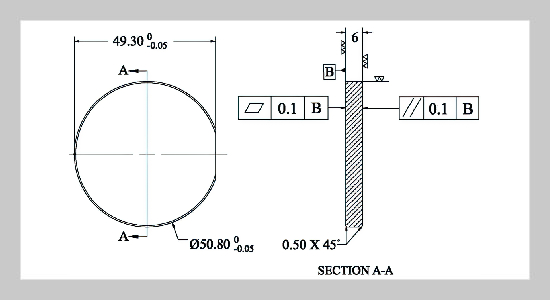- [1] Y. Yu, J. Zottis, M. Wolfgarten, and G. Hirt, (2019) “Investigation of applying protective sheet metal die covers for hot forging dies on a cross-forging geometry" The International Journal of Advanced Manufacturing Technology 102: 999–1007. DOI: 10.1007/s00170-018- 03250-4.
- [2] S. Joshy, K. Jayadevan, M. S. George, and B. Prasad, (2022) “Influence of hot forging on microstructure in double tempered H11 hot forging dies" Metallurgical Research & Technology 119(1): 115. DOI: 10.1051/metal/2022004.
- [3] X. Pan, H. Wang, Q. Liu, Z. Yao, J. Li, and C. Jiang, (2022) “High-Temperature Wear Properties of 35Ni15Cr Fe-Based Self-Lubricating Die Materials" Metals 12(12): 2016. DOI: 10.3390/met12122016.
- [4] Y. Zhou, L. Chen, W. Jiang, S. Cui, and X. Cui, (2022) “Investigation on elevated-temperature wear performance and wear failure mechanism of a tungsten-system hot�working die steel" Surface Topography: Metrology and Properties 10(3): 035007. DOI: 10.1088/2051-672X/ac7a4f.
- [5] Y. Shi, L. Yu, X. Guo, C. Cheng, P. Zuo, and Y. Dai, (2022) “High-temperature oxidation wear performance and mechanism of Cr–Mo (W)–V hot-work die steel" In�ternational Journal of Materials Research 113(1): 12–32. DOI: 10.1515/ijmr-2020-8074.
- [6] Z. Bai, N. Su, H. Yang, and X. Wu, (2022) “Wear char�acteristics of austenitic steel and martensitic steel at high temperature" Materials Research Express 9(8): 086504. DOI: 10.1088/2053-1591/ac86b9.
- [7] I. Stepankin and E. Pazdniakou, (2021) “Effect of Re�tained Austenite on the Wear Resistance of C80W1 and 90CrSi5 Tool Steels" Journal of Friction and Wear 42(4): 239–245. DOI: 10.3103/S1068366621040127.
- [8] P. Chhabra and M. Kaur, (2020) “Elevated-temperature wear study of HVOF spray Cr3C2–NiCr-coated die steels" Journal of Tribology 142(6): 061401. DOI: 10.1115/1.4046017.
- [9] K. Drozd, M. Walczak, M. Szala, and K. Gancarczyk, (2020) “Tribological behavior of AlCrSiN-coated tool steel K340 versus popular tool steel grades" Materials 13(21): 4895. DOI: 10.3390/ma13214895.
- [10] S. A. Bakdemir, D. Özkan, C. Türküz, and S. Salman, (2023) “Wear performance under dry and lubricated con�ditions of duplex treatment TiN/TiCrN coatings deposited with different numbers of CrN interlayers on steel sub�strates" Wear 526: 204931. DOI: 10.1016/j.wear.2023. 204931.
- [11] N. Sabangban, N. Mahayotsanun, S. Sucharitp�watskul, and S. Mahabunphachai, (2016) “Wear pre�diction of die coatings in strip ironing by finite element simulation" Transactions of the IMF 94(4): 199–203. DOI: 10.1080/00202967.2016.1180813.
- [12] S. Chen, H. Ding, Z. Tang, S. Hao, and Y. Zhao, (2022) “Influence of rice straw forming factors on ring die wear and improved wear prediction model during briquetting" Biosystems Engineering 214: 122–137. DOI: 10.1016/j.biosystemseng.2021.12.012.
- [13] A. Macioł, P. Macioł, and B. Mrzygłód, (2020) “Pre�diction of forging dies wear with the modified Takagi– Sugeno fuzzy identification method" Materials and Manufacturing Processes 35(6): 700–713. DOI: 10.1080/10426914.2020.1747627.
- [14] X. Qiao, A. Cheng, X. Nie, and M. Ning, (2018) “A study on die wear prediction for automobile panels stamp�ing based on dynamic model" The International Jour�nal of Advanced Manufacturing Technology 97: 1823–1833. DOI: 10.1007/s00170-018-1811-6.
- [15] C. Tan, E. Ghassemieh, and W. Goh, (2009) “Wear analysis and prediction of the life of a riveting die used in the automotive industry" Proceedings of the Insti�tution of Mechanical Engineers, Part B: Journal of Engineering Manufacture 223(11): 1395–1407. DOI: 10.1243/09544054JEM1518.
- [16] V. Jagota and R. Sharma, (2018) “Interpreting H13 steel wear behavior for austenitizing temperature, tempering time and temperature" Journal of the Brazilian Society of Mechanical Sciences and Engineering 40(4): 219. DOI: 10.1007/s40430-018-1140-6.
- [17] N. Tran Van, S. Yang, and A. Phung Tuan, (2018) “Microstructure and properties of Cu/TiB2 wear resistance composite coating on H13 steel prepared by in-situ laser cladding" Optics & Laser Technology 108: 480–486. DOI: 10.1016/j.optlastec.2018.07.036.
- [18] D. Özkan, M. A. Yilmaz, D. Karakurt, M. Szala, M. Walczak, S. A. Bakdemir, C. Türküz, and E. Sulukan, (2023) “Effect of AISI H13 steel substrate nitriding on AlCrN, ZrN, TiSiN, and TiCrN multilayer PVD coat�ings wear and friction behaviors at a different temper�ature level" Materials 16(4): 1594. DOI: 10.3390/ma16041594.
- [19] C.-l. Gui, (1990) “The Archard design calculation model and its application methods" Lubrication Engineering 15(1): 12–21.
- [20] Z.-k. Yuan, L.-j. Wu, J. Wang, P. Zhang, and Z.-z. Wei, (2022) “Optimization of superhydrophobic coatings based on neural network and genetic algorithm" Surface Tech�nology 51(1): 240–246. DOI: 10.16490/j.cnki.issn.1001-3660.2022.01.025.
- [21] T.-t. He, S. Ruo-nan, J. Liu, S.-m. Du, Y.-z. Zhang, and S.-e. Deng, (2020) “Sliding friction and wear properties of GCr15 steel under different loads" Transactions of Materials and Heat Treatment 41(7): 105–110. DOI: 10.13289/j.issn.1009-6264.2019-0553.
- [22] Z. Wang, M. Zhou, Y. Jiang, and Z. Liu, (2023) “Effects of in situ NbC on the microstructure and high-temperature friction wear properties of 4Cr5MoSiV1 steel" Journal of Materials Research and Technology 24: 6159–6173. DOI: 10.1016/j.jmrt.2023.04.221.
- [23] S. Li, X. Wu, S. Chen, and J. Li, (2016) “Wear resistance of H13 and a new hot-work die steel at high temperature" Journal of Materials Engineering and Performance 25: 2993–3006. DOI: 10.1007/s11665-016-2124-2.
- [24] S.-z. Wen, P. Huang, Y. Tian, and L.-r. Ma. Principles of tribology. Tsinghua University Press, 191–312.
- [25] B.-l. Zhu, Z.-x. Yang, and J.-j. Liu, (1989) “The mea�surement of frictional temperature and its effect in sliding contact" Tribology 9(1): 23–29.
- [26] W. Jiang, S. Wang, Y. Deng, and X. Guo, (2022) “Mi�crostructure stability and high temperature wear behavior of an austenite aging steel coating by laser cladding" Ma�terials Characterization 184: 111700. DOI: 10.1016/j.matchar.2021.111700.
- [27] Y. Qian, Y. Liang, and R. Guan, (2014) “Improving activated sludge classification based on imbalanced data" Journal of Hydroinformatics 16(6): 1331–1342. DOI: 10.2166/hydro.2014.123.
- [28] S. Feng, H. Zhou, and H. Dong, (2019) “Using deep neural network with small dataset to predict material de�fects" Materials & Design 162: 300–310. DOI: 10.1016/j.matdes.2018.11.060.
- [29] L. Guo, J.-m. Pan, J.-l. Lu, and S. Yong-xian, (2010) “Application of interpolation algorithms in smart substa�tion" Electric Power Automation Equipment 30(10): 103–105. DOI: 10.3969/j.issn.1006-6047.2010.10.023.
- [30] T. Blu, P. Thévenaz, and M. Unser, (2004) “Linear interpolation revitalized" IEEE Transactions on Image Processing 13(5): 710–719. DOI: 10.1109/TIP.2004. 826093.
















